
The Ashanti Region is located in south Ghana and is third largest of 16 administrative regions, occupying a total land surface of 24,389 km2 (9,417 sq mi) or 10.2 per cent of the total land area of Ghana. In terms of population, however, it is the most populated region with a population of 4,780,380 according to the 2011 census, accounting for 19.4% of Ghana's total population. The Ashanti Region is known for its major gold bar and cocoa production. The largest city and regional capital is Kumasi.
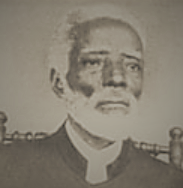
Carl Christian Reindorf was a Euro-African-born pioneer historian, teacher, farmer, trader, physician and pastor who worked with the Basel Mission on the Gold Coast. He wrote The History of the Gold Coast and Asante in the Ga language; scholars consider the book a “culturally important” work and an increasingly important source for Ghanaian history. The work was later translated into English and published in 1895 in Switzerland. He used written sources and oral tradition, interviewing more than 200 people in the course of assembling his history.

The Basel Mission was a Christian missionary society based in Switzerland. It was active from 1815 to 2001, when it transferred the operative work to Mission 21, the successor organization of Kooperation Evangelischer Kirchen und Missione (KEM), founded in 2001.

Agogo is a town in the Asante Akim North Municipal District of the Ashanti Region of Ghana. Agogo is approximately 80 kilometers east of Kumasi, the capital of the Ashanti Region, and had a population of 28,271 in the 2000 census. Computer projections estimate that the 2007 population was 32,859.

Thomas Birch Freeman was an Anglo-African Wesleyan minister, missionary, botanist and colonial official in West Africa. He is widely regarded as a pioneer of the Methodist Church in colonial West Africa, where he also established multiple schools. Some scholars view him as the “Founder of Ghana Methodism”. Freeman's missionary activities took him to Dahomey, now Benin as well as to Western Nigeria.

The arrival of the Europeans in 15th century into the then Gold Coast brought Christianity to the land. There were many different cultural groups across the West African region who were practicing different forms of spirituality. As the Europeans explored and took control of parts of the country during the colonial days, so did their religion. Christianity is the religion with the largest following in Ghana. Christian denominations include Catholics, Methodists, Anglicans, Presbyterians, Lutherans, Seventh-Day Adventists, Pentecostals, Baptists etc.

The Presbyterian Church of Ghana is a mainline Protestant church in Ghana. The oldest continuously existing established Christian church in Ghana, it was started by the Basel missionaries on 18 December 1828. The missionaries had been trained in Germany and Switzerland and arrived on the Gold Coast to spread Christianity. The work of the mission became stronger when Moravian missionaries from the West Indies arrived in the country in 1843. In 1848, the Basel Mission Church set up a seminary, now named the Presbyterian College of Education, Akropong, for the training of church workers to help in the missionary work. The Ga and Twi languages were added as part of the doctrinal text used in the training of the seminarians. In the 19th and early 20th centuries, the Presbyterian church had its missions concentrated in the southeastern parts of the Gold Coast and the peri-urban Akan hinterland. By the mid-20th century, the church had expanded and founded churches among the Asante people who lived in the middle belt of Ghana as well as the northern territories by the 1940s. The Basel missionaries left the Gold Coast during the First World War in 1917. The work of the Presbyterian church was continued by missionaries from the Church of Scotland, the mother church of the worldwide orthodox or mainstream Presbyterian denomination. The official newspaper of the church is the Christian Messenger, established by the Basel Mission in 1883. The denomination's Presbyterian sister church is the Evangelical Presbyterian Church, Ghana.

Alexander Worthy Clerk was a Jamaican Moravian pioneer missionary, teacher and clergyman who arrived in 1843 in the Danish Protectorate of Christiansborg, now Osu in Accra, Ghana, then known as the Gold Coast. He was part of the first group of 24 West Indian missionaries from Jamaica and Antigua who worked under the aegis of the Basel Evangelical Missionary Society of Switzerland. Caribbean missionary activity in Africa fit into the broader "Atlantic Missionary Movement" of the diaspora between the 1780s and the 1920s. Shortly after his arrival in Ghana, the mission appointed Clerk as the first Deacon of the Christ Presbyterian Church, Akropong, founded by the first Basel missionary survivor on the Gold Coast, Andreas Riis in 1835, as the organisation's first Protestant church in the country. Alexander Clerk is widely acknowledged and regarded as one of the pioneers of the precursor to the Presbyterian Church of Ghana. A leader in education in colonial Ghana, he established an all-male boarding middle school, the Salem School at Osu in 1843. In 1848, Clerk was an inaugural faculty member at the Basel Mission Seminary, Akropong, now known as the Presbyterian College of Education, where he was an instructor in Biblical studies. The Basel missionaries founded the Akropong seminary and normal school to train teacher-catechists in service of the mission. The college is the second oldest higher educational institution in early modern West Africa after Fourah Bay College in Freetown, Sierra Leone which was established in 1827. Clerk was the father of Nicholas Timothy Clerk, a Basel-trained theologian, who was elected the first Synod Clerk of the Presbyterian Church of the Gold Coast from 1918 to 1932 and co-founded the all boys’ boarding high school, the Presbyterian Boys’ Secondary School established in 1938. A. W. Clerk was also the progenitor of the historically important Clerk family from the suburb of Osu in Accra.
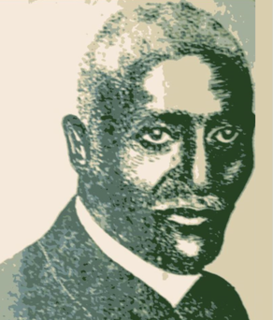
Nicholas Timothy Clerk was a Gold Coast-born theologian, clergyman and pioneering missionary of the Basel Evangelical Missionary Society who worked extensively in southeast colonial Ghana. His father was the Jamaican Moravian missionary Alexander Worthy Clerk, who worked on the Gold Coast with the Basel Mission and co-founded in 1843 the Salem School, a Presbyterian boarding middle school for boys. N. T. Clerk was elected the first Synod Clerk of the Presbyterian Church of the Gold Coast, in effect, the chief administrator and overall strategy lead of the national church organisation, a position he held from 1918 to 1932. A staunch advocate of secondary education, Nicholas Timothy Clerk became a founding father of the all-boys Presbyterian boarding school in Ghana, the Presbyterian Boys' Secondary School, established in 1938. As Synod Clerk, he pushed vigorously for and was instrumental in turning the original idea of a church mission high school into reality.
The Presbyterian College of Education, Akropong, is a co-educational teacher-training college in Akropong in the Akwapim district of the Eastern Region of Ghana. It has gone through a series of previous names, including the Presbyterian Training College, the Scottish Mission Teacher Training College, and the Basel Mission Seminary. The college is affiliated to the University of Education, Winneba.

The Ebenezer Presbyterian Church, formerly known as the Basel Mission Church, Christiansborg, is a historic Protestant church located in the suburb of Osu in Accra, Ghana. The church was founded by the Basel Evangelical Missionary Society in 1847. Previously near the Christiansborg Castle at a hamlet called Osu Amanfong, where a commemorative monument now stands, the church relocated northwards to its present location near the Salem School when a new chapel was constructed and consecrated in 1902. The church is affiliated to the Presbyterian Church of Ghana. Liturgical services are conducted in English and the Ga language.

The Christ Presbyterian Church, formerly known as the Basel Mission Church, Akropong, is a historic Protestant church located in Akropong–Akuapem, Ghana. It is the first Presbyterian Church to be established in Ghana. It was founded in 1835 by Andreas Riis, a Danish minister and missionary of the Basel Mission who was the only congregant at the time. After years of dormancy, the church began to flourish after the arrival of the Moravian missionaries from the West Indies in 1843. The Basel missionary, Johann Georg Widmann was appointed the minister-in-charge of the Akropong church in 1845. The Jamaican missionary, John Hall, who had served as an elder in his home church in Irwin Hill, Montego Bay, became the first Presbyter of the church while Alexander Worthy Clerk became the first Deacon. Liturgical services are conducted in English and the Twi language.

David Asante was a philologist, linguist, translator and the first Akan native missionary of the Basel Evangelical Missionary Society. He was the second African to be educated in Europe by the Basel Mission after the Americo-Liberian pastor, George Peter Thompson. Asante worked closely with the German missionary and philologist, Johann Gottlieb Christaller and fellow native linguists, Theophilus Opoku, Jonathan Palmer Bekoe, and Paul Staudt Keteku in the translation of the Bible into the Twi language.

Theophilus Herman Kofi Opoku was a native Akan linguist, translator, philologist, educator and missionary who became the first indigenous African to be ordained a pastor on Gold Coast soil by the Basel Mission in 1872. Opoku worked closely with the German missionary and philologist Johann Gottlieb Christaller as well as fellow native Akan linguists, David Asante, Jonathan Palmer Bekoe, and Paul Staudt Keteku in the translation of the Bible into the Twi language.

Peter Hall was a Gold Coast-born Jamaican teacher, missionary and Presbyterian clergyman who was elected the first Moderator of the Presbyterian Church of the Gold Coast, equivalent to the rank of chief executive of the national church organisation, a position he held from 1918 to 1922. Hall was the son of John Hall, one of 24 West Indian missionaries who arrived in the Danish Protectorate of Christiansborg and worked under the auspices of the Basel Evangelical Missionary Society.
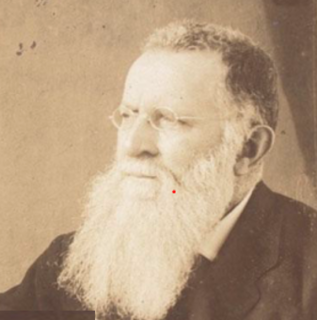
Friedrich Augustus Louis Ramseyer also Fritz Ramseyer was a Swiss-born Basel missionary, who was captured by the Asante in 1869 in colonial Ghana, together with his wife Rosa Louise Ramseyer, Basel mission technical staff, Johannes Kühne and French trader, Marie-Joseph Bonnat. Ramseyer was later released in 1874 and pioneered the Christian mission in Kumasi and the rest of Asante. Apart from his evangelism, Ramseyer was instrumental in the expansion of opportunities in the fields of education, artisan industry training, land acquisition for building design and manpower development in the Asante areas he lived and worked in.
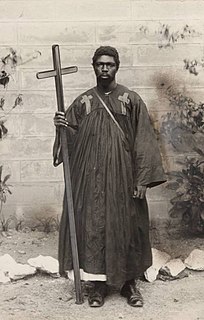
Samson Kwame Oppong also Sampson Opon or Opong was a controversial Akan Christian preacher-prophet on the Gold Coast in the 1920s. His missionary zeal, unconventional and fiery ministry helped entrench Methodism in the Ashanti and Brong-Ahafo Regions of Ghana, through a large-scale spiritual awakening and revival. Though his knowledge of Christian theology was minimal, he is known to have employed threats and other coercive techniques to proselytise in the Ghanaian towns and villages he worked in.
Kwabena Opuni Frimpong is a Ghanaian academic and Presbyterian minister who served as the General Secretary of the Christian Council of Ghana (CCG), equivalent to the chief executive officer of the ecumenical organisation. He is also a lecturer at the Kwame Nkrumah University of Science and Technology (KNUST).
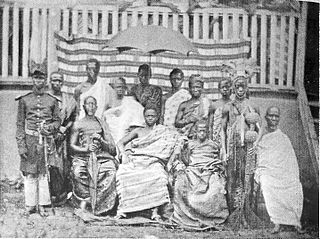
Nana Amoako Atta I,, was the paramount chief of Akyem Abuakwa in nineteenth century southern Ghana. Locally, his position is known as the Okyehene or Omanhene. He ruled the traditional kingdom from July 1866 to 1880 and from 1885 to 1887. After the Sagrenti War of 1874, the British declared Akyem Abuakwa a colonial possession, legally called a ‘protectorate’, as part of the Gold Coast. This development led to a clash between the old traditional Akan culture and the imposition of the new Western Christian political order.



















